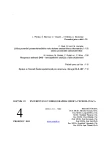-
Medical journals
- Career
Treatment of posterolateral corner injuries with anatomical reconstruction and/or high tibial osteotomy
Authors: František Okál 1; Radek Hart 1,2; Martin Komzák 1
Authors‘ workplace: Department of Orthopaedics and Traumatology, Znojmo Hospital 1; Ortopedicko-traumatologické oddělení nemocnice Znojmo 1; Department of Traumatology, Trauma Hospital Brno 2; Klinika traumatologie v Úrazové nemocnici v Brně, LF MU Brno 2
Published in: Úraz chir. 19., 2011, č.4
Overview
INTRODUCTION:
Injuries of the posterolateral corner of the knee can cause severe disability due to instability. The popliteus muscle-tendonligament complex, lateral collateral ligament, and posterolateral capsular structures are a complex combination of both dynamic and static stabilizers. There have been many reports on procedures performed to stabilize the posterolateral knee. Crutial is an anatomical reconstruction of this stabilizers. Restoration of only a portion of the posterolateral structures may result in residual instability.MATERIAL AND METHODS:
Since 2008 to 2009 we treated 6 patients with lateral knee instability. There were 5 men and 1 women, with average age 50 (range, 25 to 67). The minimum follow-up period was one year.RESULTS:
There was no serious complication, all patients are relatively satisfied. Two patients show partial lateral laxity being treated by orthosis, further surgical procedures were refused. The peroneal nerve function did not regenerate in one case, other patient showed only partial reinervation, function recovered fully for the third patient with neural palsy. Anatomical reconstruction with semitendinosus tendon together with proximal tibial opening wedge osteotomy was performed for next patient. Rotating hinge endoprosthesis was the ultimate solution for obese patient with arthrosis.DISCUSSION:
Anatomical reconstructions require recovery of the three most important structures of the posterolateral complex – lateral collateral ligament, popliteus muscle and popliteofibular ligament.CONCLUSIONS:
Posterolateral corner damage is often of a different extent and only few knees suffer one isolated injury. It is therefore difficult to assemble a consistent group of patients for comparativeness.KEY WORDS:
posterolateral corner, lateral knee laxity, surgical techniques, reconstruction.
Sources
1. BAKER, C.L., NORWOOD L.A., HUGSTON J.C. Acute posterolateral rotatory instability of the knee. J Bone Joint Surg Am. 1983, 65, 614–618.
2. BRINKMAN, J.M., SCHWERING, P.J.A., BLANKEVOORT, L. et al. The insertion geometry of the posterolateral corner of the knee. J Bone Joint Surg. 2005, 87-B, 1364–1368.
3. CLANCY, W.G. Jr., SHEPARD M.F., CAIN E.L. Jr. Posterior lateral corner reconstruction. Am J Orthop. 2003, 32, 171–176.
4. COVEY, D. C. Current concepts review injuries of the posterolateral corner of the knee J Bone Joint Surg Am. 2001, 83, 106.
5. COVEY, D. C., SAPEGA, A. A. Injuries of the posterior cruciate ligament. J Bone Joint Surg Am. 1993, 75, 1376–1386.
6. COVEY, D.C., SAPEGA, A. A, SHERMAN, G. Testing for isometry during reconstruction of the posterior cruciate ligament. Anatomic and biomechanical considerations. Am J Sports Med. 1996, 24, 740–746.
7. ČECH, O., SOSNA, A., BARTONÍČEK, J. Poranění vazivového aparátu kolenního kloubu. 1. vyd. Praha: Avicenum, 1986. 196 s.
8. DEELEE, J. C., RILEY, M. B., ROCKWOOD, C. A. Acute posterolateral rotatory instability of the knee. Am J Sports Med. 1983, 11, 199–207.
9. FANELLI, G.C., FELDMANN, D.D. Management of combined ACL/PCL/ posterolateral complex injuries of the knee. Oper Tech Sports Med. 1999, 7, 143–149.
10. FORNALSKI, S., et al. Biomechanical and Anatomical Assessment After Knee Hyperextension Injury. Am J Sports Med 2008, 36, 80.
11. HARNER, C. D., VOGRIN, T. M., HOHER, J. et al. Biomechanical analysis of a posterior cruciate ligament reconstruction. Deficiency of the posterolateral structures as a cause of graft failure. Am J Sports Med. 2000, 28, 32–39.
12. HART, R., ŠTIPČÁK, V. Přední zkřížený vaz kolenního kloubu. 1. vyd. Praha: Maxdorf Jessenius, 2010. 224 s.
13. HUGSTON J.C, ANDREXS, J.R. et al. Classification of knee ligament instabilities. Part II. The lateral compartment. J Bone Joint Surg Am. 1976, 58-A, 173–179.
14. JUHUNG, S., LEE, J.K. et al. MR evaluation of the “arcuate” sign of posterolateral knee instability. AJR Am J Roentgenol. 2002, 178, 583–588.
15. LAPRADE, R., TERRY., G. Injuries to the posterolateral aspect of the knee: association of anatomic injury patterns with clinical instability. Am J Sports Med. 1997, 25, 433–438.
16. MAYNARD, M.J., DENG, X., WICKIEWICZ, T. WARREN, R.F. The popliteofibular ligament: rediscovery of a key element in posterolateral stability. Am J Sports Med. 1996, 24, 311–315.
17. SEEBACHER, J. R., INGLIS, A. E., MARSHALL, J. L., WARREN, R. F. The structure of the posterolateral aspect of the knee. J Bone Joint Surg Am. 1982, 64, 536–541.
18. VELTRI, D. M., WARREN, R.F. Operative treatment of posterolateral instability of the knee. Clin Sports Med. 1994, 13, 615–627.
19. VELTRI, D. M. et al. The role of the cruciate and posterolateral ligaments in stability of the knee. A biomechanice study. Am J Sports Med. 1995, 23, 436–43.
20. VELTRI, D. M., WARREN, R. Instructional Course Lecture, American Academy of Orthopaedic Surgeons. Posterolateral instability of the knee. J Bone Joint Surg Am. 1994, 76, 460–472.
Labels
Surgery Traumatology Trauma surgery
Article was published inTrauma Surgery

2011 Issue 4
Most read in this issue- Treatment of posterolateral corner injuries with anatomical reconstruction and/or high tibial osteotomy
- Reoperation of the DHS failure – retrospective analysis and our experience
- Liver injury in children
Login#ADS_BOTTOM_SCRIPTS#Forgotten passwordEnter the email address that you registered with. We will send you instructions on how to set a new password.
- Career

